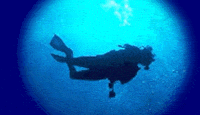|
Dodd Narrows:
Situated
5 nautical miles SE of Nanaimo, Dodd Narrows is rated the #2 dive site
in BC. Only 55 metres wide at the narrowest point with a max depth of
33 metres. The 8-9 knot currents in this picturesque channel create an
ideal habitat for a lush assortment of colourful marine invertebrates.
Due to the strong currents, Dodd Narrows can only be dived from a boat
at slack water. The Mudge Island side of the Narrows with it's heavily
colonized sheer vertical faces and overhangs is the diver's preferred
bank. Living in Dodd Narrows are many species of Sea Anemone, Aggregating
Anemone, Sea Stars, Mosshead Warbonnets, Puget Sound King Crab, Orange
Cup Corals, Red Irish Lords, Rockfish and Cod. Occasionally during the
winter months California and Stellar Sea Lions can be observed feeding
on Salmon in the swift tidal stream. A photographers dream!
Snake Island:
Snake
Island (a bird sanctuary) is a wall dive starting in 20 metres of water
and descending vertically to well over 200 metres. Most notable on the
wall are large colonies of Cloud Sponges and Plumose Anemones. This is
a deep diving favourite and the shallow water ledges provide an ideal
and most suitable area for safety stops. Here divers and snorkellers
can pass the time interacting with one of the 250 Friendly Harbour
Seals that have made this site their home.
Former HMCS Saskatchewan: (Just
10 minutes by boat from The Buccaneer Inn)
Snake
Island home to Canada's most popular artificial reefs. On the Saskatchewan
alone there have been more dives completed than the cumulative total
of
all of B.C.’s artificial reefs! This 110m ex-Canadian Navy destroyer
escort is situated between 12-40 metres of water, making Snake Island
an excellent two-dive destination. The Saskatchewan has been extensively
prepared for diver access and when combined with a gentle bottom current
and excellent visibility year round, she truly lives up to her ship's
motto, " the Best in the West".
Former HMCS Cape Breton: (Just
10 minutes by boat from The Buccaneer Inn)
The
Cape Breton is Canada's largest diver-prepared artificial reef and the
second largest in the world! This former WWII Victory ship underwent a
stringent preparation and cleaning process prior to being scuttled on
October 21, 2001. The triple expansion steam engine was removed in dry
dock and was donated to a future museum commemorating the North Vancouver
shipyards. Also donated was 42' of the stern. The Cape Breton sits at
140' and is accessible to most divers. She is 400' feet in length and
approximately 100' in height. There is a special message from us at The
Buccaneer to you at the bottom of the engine compartment!
Four Fathom Reef:
An
underwater pinnacle rises as shallow as 8 metres from a sea floor depth
of 4o+ metres. Four Fathom is known locally as a prolific spawning ground
for all species of Rock Fish, Lingcod, Greenling, Cabezon, Spiny Pink
(swimming) Scallops and Giant Pacific Octopus. Here, divers have a good
chance of seeing the Octopus out of their dens during daylight hours.
Clarke Rock:
A
dual pinnacle site that comes as close as 3 metres to the surface from
the surrounding 30+ metre sea floor. Many species of Rock Fish live here
although this site is most popular for it's tall chimney sponges, sea
pens and wildly coloured Nudibranchs. Wolf Eel and Giant Pacific Octopus
can be seen on occasion.
Jesse Island:
This
small island located in Departure Bay boasts at least 3 separate and
distinct dive sites in very sheltered conditions. Each site has a unique ecology
ranging from rock pillars, sea caves, walls, gentle bottom slopes and
pinnacles. Marine life varies widely from site to site. and is a very
popular night dive location.
You
can expect to see everything from dainty to full size specimens of Giant
(swimming) Nudibranchs, Sea Pens, Sea Whips, Plumose Anemones, rare Crimson
Anemones, Sea Perch, Cabezon, Lingcod, Wolf Eels and Octopus.
|




